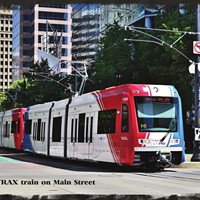Page 3 of 3
The first two developers for the Clearfield TOD appear to have been connected to Diehl, who got a pass from his former UTA board to continue making deals. For Diehl, the board voted in a closed meeting to waive the one-year prohibition on former board members to do business with UTA.
Diehl filed a Chapter 11 bankruptcy in 2012, saying he owes $43 million to creditors. But in 2011, a legislative audit showed he made millions (less than $24 million, according to a Salt Lake Tribune records request) from work on the Draper FrontRunner site. Still, the UTA board has managed to profit from the TOD there. Former board member Greg Haws is representing Draper Holding as it continues to develop the site.
Diehl must have had hopes for the Clearfield site, too. The first developer, Lee Conant, was known to work with Diehl’s company, Wasatch Pacific. Conant, according to Wood, sold his interests to the second prospective developer, Wasatch Pacific. But profit isn’t illegal.
Diehl’s attorney has said he needed only to disclose his conflict, and that he resigned from the board after a decade so he could go after TODs. And he has done just that.
In fact, it appears that only a handful of developers are considered to work on these TODs. While Oliver said there was no need for a public “request for quotation,” Barron says that’s untrue and the Clearfield TOD was subject to a public procurement process.
Clearing the
Air (Not)
While UTA is concentrating on development around TODs, it’s cutting back on service connections and doing very little to clear the air.
Nationally, cities have taken two tacks to deal with increasing air toxicity. One, a technical strategy, has made strides toward improving air quality, according to O’Toole. Traffic speeds have been increased and emissions from exhaust greatly reduced. The other is behavioral, and its results have been a dismal failure.
“Per capita driving in urban areas has more than doubled since the 1970s, and no city has managed to reduce per capita driving by even 1 percent, except for short periods of time when gas prices were high,” he says.
According to a 2008 legislative performance audit of UTA, “if light rail were to double ridership and carry 4 percent of all commuters instead of the 2 percent currently carried, the effect on reduced air emissions would be minimal at only 3.4 tons, or 0.01 percent of the total NOx emitted in the four counties served by UTA.”
Here are the facts, from the 2008 performance audit: While light rail and vanpools reduce nitrogen oxide (NOx), light rail in Utah gets its power from coal-fired plants, and that means more NOx and CO2. Vanpools consolidate trips, but bus emissions outweigh those benefits because many of UTA’s buses are old. And finally, the only real way to reduce NOx will come from technological improvements in automobile engines, the report says.
UTA, however, touts its efforts to upgrade buses. “In 2010, UTA partnered with Utah Clean Cities Coalition to purchase 20 hybrid-electric clean-diesel buses,” a UTA report says. “Today, over 50 percent of UTA’s transit bus fleet are clean-diesel buses, as defined by the EPA, which reduces UTA’s emissions of PM and NOx by more than 60 percent.”
UTA points to a more complimentary 2011 audit that shows it’s been steadily reducing emissions by more than half since 2007. “One way we have accomplished that is through our anti-idling campaign for our buses,” Barron says.
Salt Lake City Councilman Soren Simonsen dismisses the pollution problem. “Every person is a net polluter,” he says. “If you flush your toilet, you pollute. All are byproducts of simply living in Utah.”
O’Toole notes that in Portland, most of the electricity comes from hydropower. In Salt Lake, electricity is generated largely from fossil fuels.
In Minneapolis-Saint Paul, the city built a light-rail system while moving to hybrid-electric buses. “Hybrid-electric buses are ... 3.5 times more cost-effective at reducing greenhouse gases than light rail,” O’Toole wrote. The city also began using a 20 percent biodiesel mix of fuel in its buses—which, O’Toole found, was 25 times more cost-effective at reducing greenhouse gases than light rail.
“If Utah wants to clean the air still further, it should adopt the PZEV standard that has been adopted by 13 others states,” O’Toole says. “A ‘partial zero emission vehicle,’ PZEV has improved catalytic converters and a sealed fuel system so that gasoline vapors don’t escape into the atmosphere. These things add about $200 to the price of a new car but cut toxic emissions in about half—some reports say by as much as 70 percent.”
UTA is beginning to use a biodiesel mix in its buses, but had only three hybrid buses in operation at the time of the 2008 audit.
In the 2013 session, the Utah Legislature passed Senate Bill 275, ostensibly to begin a modest effort at cleaning the air by constructing more natural-gas fueling stations. In essence, the bill allows gas corporations (Questar) to spend up to $5 million to construct these stations to convert vehicles to natural gas, and allows the possibility of adding to the rate structure if more are needed.
Claire Geddes believes it’s a sneaky way of adding costs to ratepayers, since the small number of conversions would barely affect pollution counts. Whether true or not, it shows desperation on the part of lawmakers to ameliorate the poor air quality in Utah.

And, critics say, if you cloak an idea in terms of better air quality, you can get away with almost anything.
Privatize This
But it’s not easy being a critic. “If you speak out against mass transit, you’re a leper,” Geddes says. “My own legislator won’t even return my calls.”
Frankel thinks the time has come to end the charade. “If you’re a businessman appointed to the UTA board, you’re above the law,” he says. “UTA doesn’t make good transit decisions. They make them for wealthy developers, and cronyism is expensive. Good transit projects pay for themselves.”
Simonsen, who’s a longtime supporter of UTA, sees funding as the biggest problem facing the agency, but also thinks UTA could offer free transit service. It’s not much of a stretch, he says, considering that farebox revenues—$35 million in 2010—provide only a small portion of overall funding.
“In 2010, fares paid by transit users covered 20 percent of UTA’s operating costs, an improvement from 17 percent in 2006,” the 2012 audit says. “Farebox recovery is important because costs not covered by transit users are subsidized by taxpayers.”
UTA plans to up farebox recovery to 30 percent by 2020. But, the audit says, “while UTA’s planned changes are promising, the ability to implement them remains unclear ... it seems reasonable for users to pay more of UTA’s transit costs, [but] their willingness to do so is not yet clear.”
Frankel didn’t start out to dog the agency. His group had an interest only in protecting certain lands that had developers salivating. Now, however, he thinks UTA should either be folded into the Utah Department of Transportation (UDOT) or privatized.
Privatization, in fact, is what the Cato Institute recommends—sort of. As UTA is highly subsidized, it currently has no profit motive. “While privatization of transit could improve the efficiency of transit service, it is unlikely that even private operators would ever choose to build rail-transit lines in the United States,” O’Toole wrote. “Once existing lines were worn out, they would probably replace most of them with buses.”
Frankel sees privatization as one solution. “This fourth branch of government, quasi-governmental, with nonprofit status, taking sales tax money—some from the state, some from the feds, but saying they’re private, so ‘screw you,’ isn’t working,” he says.
If not privatized, then UTA should be placed under the UDOT, where there’s at least some accountability, Frankel says.
“The UTA experiment needs to be extinguished,” he says. But until the incentives change, that is unlikely to happen.
